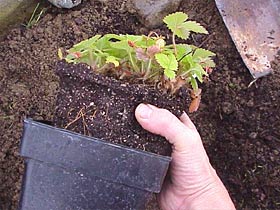
Planting must be a primal urge. Even self-proclaimed non-gardeners can be found popping in a new shrub, patching the lawn, or potting up some geraniums. Whether you are planting a shade tree, flowering shrub, new lawn, or flower and vegetable garden, using the right tools and the proper techniques will not only make planting less of a chore, but also a greater success.
Plant a Tree or Shrub
Trees and shrubs are long-term investments, so they are worth taking the time and effort to get your prized plants off to a good start. Keep in mind the ultimate size of the tree or shrub you're planting. An oak tree will eventually grow to more than 60 feet tall and wide, shading and perhaps interfering with power lines or house structures. Pick a location where your plant is most likely to thrive. Most trees and shrubs like to grow in full sun, on well-drained, fertile soil. Using a spade, dig a hole as deep as the root ball of the tree or shrub and 2 to 3 times as wide. Place the soil to the side and position the tree in the center of the hole so the top of the root ball is level with the surface of the ground. Remove any metal caging or plastic container. Prune any damaged roots with hand pruners. Untie, but leave on, any burlap. If the soil is poor, mix in some compost and backfill the hole while adding water. If the soil is fairly fertile, don't amend it. Fill the hole with soil until it's level with the native soil. Build a small moat around the plant to catch and hold water. Cover the soil with a 2- to 4-inch-thick layer of mulch, such as shredded bark, keeping it a couple of inches away from the trunk.
Plant a Lawn
Your lawn is the gathering place in your yard. Like parents, it gets all the abuse, and often, not enough care. If a lawn area is suffering or if you're starting with a new yard at a new home, you'll need to follow some specific steps when seeding or planting a lawn for the best success. Like any garden, a healthy lawn starts with the soil. Most lawn grasses grow best with a 4- to 6-inch-thick layer of topsoil amended with compost. Have your soil tested and based on the results, amend the soil with lime or sulfur to adjust the pH to fall between 6 and 7. With a soil rake, smooth the planting area, filling in low spots and reducing the height of raised areas. Select the grass seed appropriate for your area and use a lawn spreader to distribute the seed, walking back and forth across the area and overlapping rows by a few inches. Cover the seeded area with straw, and water to keep it moist. When planting sod or grass sprigs, amend the soil as with seeding. Order the appropriate plugs or sprigs for your area. Lay them out in a grid pattern about 4 to 6 inches apart. With a hand trowel, dig holes and plant the plugs. Water well and keep the area moist.
Plant a Flower or Vegetable Garden
The key to planting an annual flower or vegetable garden is soil preparation. Those young seedlings need the best soil possible to grow into the luscious vegetables and gorgeous flowers you expect by summer. Spread a 1- to 2-inch-thick layer of compost over the garden area. Using a spade or digging fork, loosen the soil in the bed, mixing in the compost. Rake it smooth, removing stones, sticks, and other debris. For vegetables, build a raised bed 3 feet wide, 8 to 10 inches tall and as long as you need. Flatten the top of the raised bed with a rake. Make rows for vegetable seeds with a cultivator or hoe, and press the soil lightly after seeding to create good soil and seed contact. Water well. For flower beds, loosen the soil with a garden fork, incorporating the compost and any other organic matter. Smooth out the planting area with a rake.
Transplant seedlings using a hand trowel or cultivator. Plant seedlings at the same depth they were in the container. The exception is tomatoes, which can be planted deeper since they will root all along the stem. Firm the soil around the seedlings, and keep them well watered.